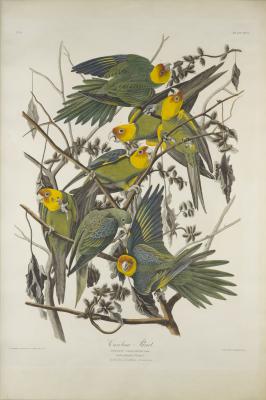
Audubon’s ambitious goal was to illustrate all the species of North American birds at life size. In the 1820s and ’30s, a publication on this scale and of this inclusiveness had never been attempted. Among the qualities that raise Audubon’s nature illustrations to the level of fine art is his determination to present each species “in nature’s own way, alive and moving.” Since the Carolina parrot (now called parakeet) has been extinct for almost a century, Audubon’s observations of the birds in their habitat must substitute for the vanished creature. He arranges a group so that some demonstrate feeding behavior and others interaction or aggression. He was extremely careful in studying specimens in order to depict the shapes and features of different ages and both sexes for each species. One immature parakeet can be identified by its different colors. Two birds spread their wings and tail feathers so that otherwise hidden patterns can be observed.
Audubon spent time in natural areas to study wild birds. He watched parakeets devour fruit and grain in farm fields, so numerous that they seemed like “a brilliantly coloured carpet.” He observed them being killed in the hundreds by farmers protecting their crops. Even in the 1820s, Audubon realized that their numbers had been greatly reduced, on the path to extinction.

